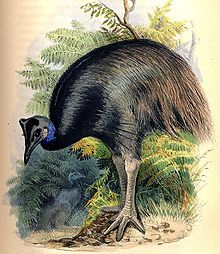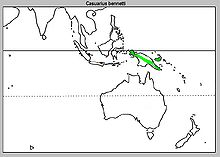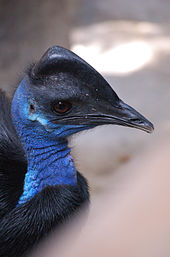- Dwarf Cassowary
-
Dwarf Cassowary 
Conservation status Scientific classification Kingdom: Animalia Phylum: Chordata Class: Aves Order: Struthioniformes Family: Casuariidae Genus: Casuarius Species: C. bennetti Binomial name Casuarius bennetti
Gould, 1857[2]
Distribution of the Dwarf Cassowary The Dwarf Cassowary, Casuarius bennetti, also known as the Bennett's Cassowary, Little Cassowary, Mountain Cassowary,[2] or Mooruk, is the smallest of the three species of cassowaries.
Contents
Taxonomy
The scientific name commemorates the Australian naturalist George Bennett.[3] He was the first scientist to examine these birds after a few were brought to Australia aboard a ship. Recognising them as representing a new species of cassowary, he sent specimens back to England where this was confirmed. On the west side of Geelvink Bay, western Irian, there exist a distinctive form that may merit a split. C. papuanus is the tentative name.[2] Finally there are no officially recognized sub-species, however, some authors believe there should be.[4][5]
The Karam of the New Guinea Highlands identify bats and flying birds as one classification (yaket), and the Dwarf Cassowary, an extremely large wingless, flightless bird as another classification (kobtiy). Whereas yaket are bony with wings and fly in the air, kobtiy are bony without wings and are terrestrial and of the forest. Kobtiy are different from other bony wingless animals in that the kobtiy are not quadrupedal, like dogs and lizards, and are not limbless, like snakes.[6]
John Gould first identified the Dwarf Cassowary from a specimen from New Britain, in 1857.[2]
Breeding Population and Trends[7] Location Population Trend Central Papua New Guinea Unknown Declining New Britain Unknown Declining Yapen Unknown Declining Total Unknown Moderately Declining Description
It is large, at between 99 to 135 centimetres (3.25–4.43 ft) tall and 18 kilograms (40 lb), flightless bird with hard and stiff black plumage, a low triangular casque, pink cheek and red patches of skin on its blue neck.[2] The feet are large and powerful, equipped with dagger-like claws on the inner toe. Both sexes are similar. Females have longer casques, brighter bare skin color and are larger in size.
Range and habitat
The Dwarf Cassowary is distributed throughout mountain forests of New Guinea, New Britain, and Yapen Island,[8] at elevations up to 3,300 m (10,800 ft). In areas without other species of cassowaries, it will live in the lowlands also.[2] Its diet consists mainly of fallen fruits and small animals, and insects. A solitary bird, it pairs only in breeding season.[2]
Conservation
Due to ongoing habitat loss, habitat degradation, being hunted for food, and often being kept in captivity, the Dwarf Cassowary is evaluated as Near Threatened on the IUCN Red List of Threatened Species,[1] with an occurrence range of 258,000 km2 (100,000 sq mi).[7]
Notes
- ^ a b BirdLife International (2008)
- ^ a b c d e f g Davies, S. J. J. F. (2003)
- ^ Gotch, A. F. (1995)
- ^ Avibase 2009
- ^ Brands, S. (2008)
- ^ Bulmer, Ralph (1967). "Why is the Cassowary Not a Bird? A Problem of Zoological Taxonomy Among the Karam of the New Guinea Highlands". Man 2 (1): 5–25.
- ^ a b BirdLife International (2008)(a)
- ^ Clements, J (2007)
References
- Avibase
- Bennett, George (1860), Gatherings of a naturalist in Australasia, John Van Voorst, London
- BirdLife International (2008). Casuarius bennetti. In: IUCN 2008. IUCN Red List of Threatened Species. Downloaded on 05 November 2008.
- BirdLife International (2008(a)). "Dwarf Cassowary - BirdLife Species Factsheet". Data Zone. http://www.birdlife.org/datazone/species/index.html?action=SpcHTMDetails.asp&sid=5&m=1. Retrieved 06 Feb 2009.
- Brands, Sheila (Aug 14 2008). "Systema Naturae 2000 / Classification, Casuarius bennetti". Project: The Taxonomicon. http://www.taxonomy.nl/Main/Classification/93147.htm. Retrieved Feb 04 2009.
- Clements, James (2007). The Clements Checklist of the Birds of the World (6 ed.). Ithaca, New York: Cornell University Press. ISBN 978 0 8014 4501 9.
- Davies, S.J.J.F. (2003). "Cassowaries". In Hutchins, Michael. Grzimek's Animal Life Encyclopedia. 8 Birds I Tinamous and Ratites to Hoatzins (2 ed.). Farmington Hills, Michigan: Gale Group. ISBN 0 7876 5784 0.
- Encyclopædia Britannica Eleventh Edition.
 This article incorporates text from a publication now in the public domain: Chisholm, Hugh, ed (1911). Encyclopædia Britannica (11th ed.). Cambridge University Press.
This article incorporates text from a publication now in the public domain: Chisholm, Hugh, ed (1911). Encyclopædia Britannica (11th ed.). Cambridge University Press. - Gotch, A.F. (1995) [1979]. "Cassowaries". Latin Names Explained. A Guide to the Scientific Classifications of Reptiles, Birds & Mammals. London: Facts on File. pp. 178–179. ISBN 0 8160 3377 3.
External links
Cassowaries and emus (family: Casuariidae) Subfamily Cassowaries (Casuariinae) CasuariusSouthern Cassowary (C. casuarius) • Dwarf Cassowary (C. bennetti) • Northern Cassowary (C. unappendiculatus) • †C. lydekkiEmus (Dromaiinae) Emu (D. novaehollandiae) (supporting page: †Tasmanian Emu (D. n. diemenensis)) • †Kangaroo Island Emu (D. baudinianus) • †King Island Emu (D. ater) • †D. ocypus†E. guljaruba • †E. gidjuCategories:- IUCN Red List endangered species
- Casuarius
- Casuariidae
- Birds of Western New Guinea
- Birds of Papua New Guinea
- Flightless birds
- Animals described in 1857
Wikimedia Foundation. 2010.





